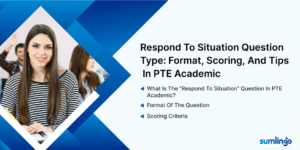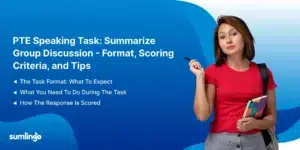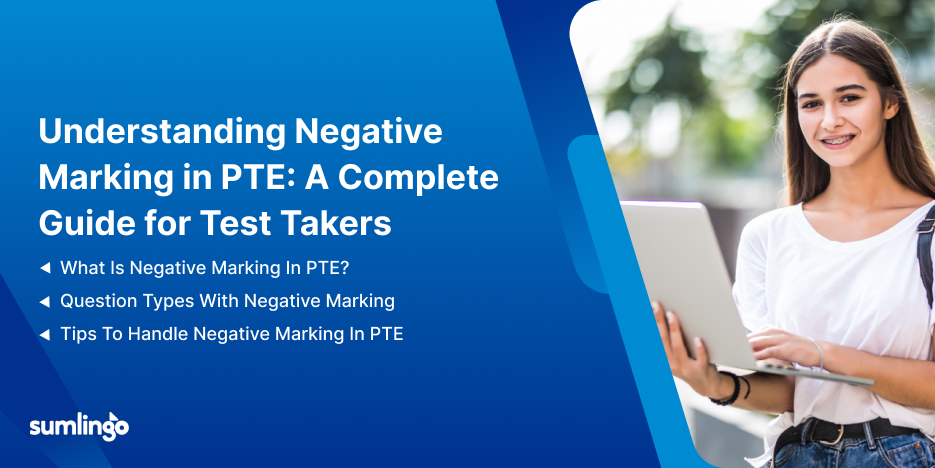In the PTE Academic exam, you’ll encounter various question types that test your English proficiency across speaking, writing, reading, and listening. One of the key speaking tasks is the Respond to Situation question, where you’re asked to react verbally to a short scenario. It’s an important question type in the exam, as it helps measure your communication skills in real-life contexts. In this blog, we will cover what this question type involves, its format, how it is scored, and some useful tips to help you perform well.
Are you ready to test your skills?
1. What is the “Respond to Situation” Question in PTE Academic?
The Respond to Situation question in the PTE Academic exam assesses your ability to listen to and read a description of a real-life situation, and then respond to it verbally. This task evaluates how well you understand the situation and express yourself clearly in English.
2. Format of the Question
- Task: You will be given a prompt that describes a specific situation or interaction. The prompt could be a simple scenario involving a conversation or a daily-life situation.
- Prompt Length: The prompt will be up to 60 words long. It will provide enough context to understand the situation.
- Skills Assessed: This question focuses on your speaking skills, specifically your ability to respond to an everyday scenario.
- Time to Respond: After reading the prompt, you will have 10 seconds to prepare. When you hear the beep, you will have 40 seconds to speak your response.
- Number of Questions: Typically, you will have 2-3 questions of this type in the PTE Academic exam.
3. Scoring Criteria
Your response to the Respond to Situation question will be evaluated based on three main criteria: Content, Pronunciation, and Fluency. Here’s how each area is scored:
Content (0-6)
This refers to how well your response addresses the situation in the prompt. You should ensure that your response is clear, relevant, and complete.
| Score | Description |
| 6 | The response fully addresses the situation with all necessary details. It’s clear, well- structured, and highly relevant to the prompt. |
| 5 | The response is clear and addresses the situation adequately. It may have minor omissions or misinterpretations, but the core message is conveyed. |
| 4 | The response addresses the situation but lacks some important details. It’s understandable, but it lacks full development. |
| 3 | The response partially addresses the communication goal. The ideas are somewhat unclear or incomplete. |
| 2 | The response is only partially relevant. There are significant gaps or misunderstandings, making the meaning unclear. |
| 1 | The response does not address the situation effectively. It’s unclear, disorganized, or off-topic. |
| 0 | No meaningful response. The answer is completely irrelevant or not given. |
Pronunciation (0-5)
Pronunciation is crucial because it determines how easily your answer can be understood. Clear pronunciation will help you score higher in this section.
| Score | Description |
| 5 | Pronunciation is clear and accurate. All vowels and consonants are well-pronounced, making the response easy to understand. |
| 4 | Pronunciation is mostly clear with only minor distortions. There are no major issues in understanding your speech. |
| 3 | Pronunciation errors are present but do not significantly affect understanding. Some words may be unclear. |
| 2 | Frequent pronunciation mistakes make the speech harder to understand. Listeners may need to adjust to the accent. |
| 1 | Pronunciation is poor, and many words are difficult to understand. |
| 0 | Pronunciation is so unclear that it is nearly impossible to understand the response. |
Fluency (0-5)
Fluency refers to the smoothness of your speech. Your response must sound natural, with little to no hesitation or repetition.
| Score | Description |
| 5 | Speech is smooth with no hesitations, repetitions, or false starts. It flows naturally and is easy to follow. |
| 4 | Speech has a good rhythm with only one or two small hesitations. There are no significant interruptions. |
| 3 | Speech is generally understandable but may have a few hesitations or pauses. The flow is acceptable but not perfect. |
| 2 | Speech has an uneven rhythm with noticeable pauses or hesitations. It may feel staccato or interrupted. |
| 1 | Speech is disjointed with multiple hesitations, pauses, or false starts. The response is difficult to follow. |
| 0 | Speech is slow and not fluent with frequent long pauses. The response is hard to understand due to disjointed speech. |
4. Tips to attempt Respond to Situation Question
Here are some practical tips to help you do well in the Respond to Situation question:
- Understand the Situation: Make sure you carefully read the prompt and understand the context. Pay attention to the details to avoid misunderstandings.
- Organize Your Thoughts: You have 10 seconds to prepare, so use this time to think about the main points you want to cover in your response. Structure your answer logically.
- Be Direct and Relevant: Focus on answering the question directly. Avoid going off-topic or adding
unnecessary information. Keep your response clear and concise.
- Use Simple and Clear Language: Don’t overcomplicate your speech. Stick to simple words and phrases to ensure clarity.
- Stay Calm and Confident: Speak clearly and at a steady pace. If you feel nervous, take a deep breath and stay calm. Confidence helps with fluency and pronunciation.
- Practice Regularly: The more you practice speaking in different scenarios, the more comfortable and fluent you will become. Practice will also help you become quicker in organizing your thoughts.
PTE Academic Respond to Situation – Sample Questions
Here’s an example of what a typical Respond to Situation question looks like, along with a sample response.
Question 1:
You are at the airport and find out your flight has been delayed by several hours. You approach the airline staff to ask for assistance. What would you say?
Sample Answer:
Hello, I just received the update that my flight to Delhi has been delayed by over three hours. Could you please let me know the exact reason for the delay and the new departure time? Also, I’d like to ask if passengers will be provided with refreshments or any lounge access since it’s quite a long wait. I have a connecting flight after reaching Delhi, so I need to understand if this delay will affect that as well. I’d appreciate your help in clarifying the situation.
Question 2:
You’ve graduated recently and need your academic transcript for a job application. You visit the university office to request it urgently. What would you say?
Sample Answer:
Good morning sir, I recently completed my degree here and I urgently need my official transcript to apply for a job abroad. The deadline for submission is in just a few days, so I wanted to ask if there’s a way to fast-track the process. I’ve already filled out the request form online but haven’t received any update yet. Could you please check the status or let me know if I can collect it in person? I’d be grateful for any help in speeding up the issuance of my transcript.
Are you ready to test your skills?
In Conclusion
The Respond to Situation question in the PTE Academic exam is a crucial task that tests your ability to respond clearly and fluently to everyday scenarios. Understanding the format and focusing on key aspects like content, pronunciation, and fluency will help you perform well and achieve a higher score. To boost your preparation, platforms like Sumlingo.com offer updated material specifically designed to enhance your skills and increase your score.










